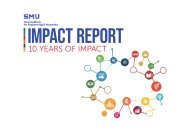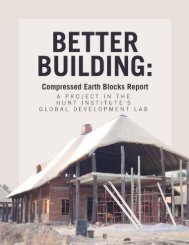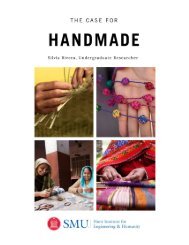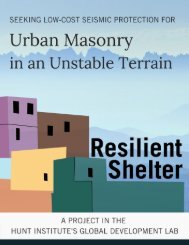Assessment of Rwanda Refugee Camps in the Context of the Villagization Process
Undergraduate researcher for the Hunt Institute for Engineering and Humanity and Engaged Learning Fellow Sienna Dugan, researched secondary sources and primary research through site visits, participatory observation, and interviews with key informants to compile this report which is structured like a case study with additional literature review. All photography is original to the student from her in-field research.
Undergraduate researcher for the Hunt Institute for Engineering and Humanity and Engaged Learning Fellow Sienna Dugan, researched secondary sources and primary research through site visits, participatory observation, and interviews with key informants to compile this report which is structured like a case study with additional literature review. All photography is original to the student from her in-field research.
You also want an ePaper? Increase the reach of your titles
YUMPU automatically turns print PDFs into web optimized ePapers that Google loves.
done looking at the economic impact of Congolese refugees in Rwanda shows that “an additional
adult refugee receiving cash aid increases annual real income in the local economy by $205 to
$253, significantly more than the $120 in aid each refugee receives”.23 With consideration of the
possible benefits of offering nationalization opportunities to those displaced and the issues that
arise from protracted situations and declining international aid, achievement of the goals set out in
the Comprehensive Refugee Response Framework will act as a foundation for the villagization
process.
Recorded problems can be divided into categories of the implementation of these processes
and the experience of living in the new villages. Within the first category falls the use of force
which fostered resentment among rural populations, the lack of adequate planning, the lack of
consultation with people involved, the speed with which villagization is often carried out, and the
lack of services which have been promised. The second category includes problems relating to the
physical location of the villages, adverse effects on the environment and particularly on the land
used for farming or grazing, the increased risk of communicable diseases, and adverse effects on
social equity or community harmony.24
For successful implementation of the process of villagization, more land needs to be
allocated to the refugees therefore increasing the standard of living and allowing for the
development of commerce zones. In-kind donations need to be allotted to bettering the community
which will follow the suggestions of the microeconomic theory which state, “provision of aid in
23 Taylor JE, Filipski MJ, Alloush M, Gupta A, Rojas Valdes RI, Gonzalez-Estrada E. Economic impact of refugees. Proc Natl Acad Sci U S A.
2016;113(27):7449–7453. doi:10.1073/pnas.1604566113
24 Lorgen. “Report on the Experience of Villagisation: Lessons from Ethiopia, Mozambique, and Tanzania.” Mokoro, 1999, mokoro.co.uk/landrights-article/report-on-the-experience-of-villagisation-lessons-from-ethiopia-mozambique-and-tanzania/.
30














